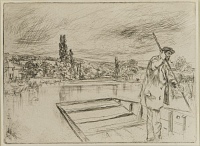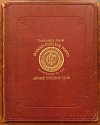Etchings Institutions search term: grolier club
The Punt | ||
| Number: | 82 | |
| Date: | 1861 | |
| Medium: | etching and drypoint | |
| Size: | 120 x 166 mm | |
| Signed: | 'Whistler' at lower left (1-3); 'W' partly removed (4-final) | |
| Inscribed: | '1861.' at lower left (1-3); partly removed (4-final) | |
| Set/Publication: | Junior Etching Club, 1862 | |
| No. of States: | 6 | |
| Known impressions: | 35 | |
| Catalogues: | K.85; M.86; T.85; W.68 | |
| Impressions taken from this plate (35) | ||
PUBLICATION
According to the Pennells: 'Other work he showed elsewhere was also praised. The Punt and Sketching, published in Passages from Modern English Poets, were at once singled out for admiration.' 12 There was a certain amount of truth in this assertion.
F.G. Stephens in The Athenaeum found Whistler's two etchings 'beyond praise' and Charles Mackay in The London Review, commented 'Mr. Whistler, a man with a most genuine gift for etching, sends two designs. In 'The Angler' the water is liquid, the knolled distance with trees pretty, and the sky, though scratchy, has motion and recession.' 13
Three years later, when the volume was re-issued, one journalist stated: 'Of the landscape prints the contributions of Mr. Whistler are much the best'. 14 The Morning Post added, moderately: ''The Angler's Soliloquy' is illustrated by Whistler, and though sketchy, is very suggestive.' And, appropriately, a review in The Sporting Gazette Limited praised: 'two charming aquatic subjects by J. Whistler, though only slight sketches, are highly effective, and display no little artistic ability. They are Plate 7, 'The Angler', in illustration of Reynolds' 'Angler's Saliloquy' [sic] and 45 'River scene', to which Charles Mackay's pleasing verses gave birth.' 15
12: Pennell 1908 , I, pp. 91-92, 96-97.
13: The Athenaeum, 7 June 1862, p. 765; 'Art and Science. The Junior Etching Club', The London Review ..., 6 September 1862, p. 218. See also The Lady's Newspaper, 14 June 1862, p. 370. Thanks to Martin Hopkinson for this and many other references!
14: Pall Mall Gazette, 18 December 1865. See also The Standard, 25 December 1865, p. 6.
15: Morning Post, London, 19 December 1865, p. 2; The Sporting Gazette Limited, 6 January 1866, p. 3.
EXHIBITIONS
 ), and by the Caxton Club in Chicago in 1900, lent by Howard Mansfield (1849-1938). 16
), and by the Caxton Club in Chicago in 1900, lent by Howard Mansfield (1849-1938). 16
Impressions were exhibited by print dealers, particularly by H. Wunderlich & Co. in New York in 1898 (
 , bought by Charles Lang Freer (1856-1919)) and 1903, and also by Obach & Co. in London in 1903.
17
, bought by Charles Lang Freer (1856-1919)) and 1903, and also by Obach & Co. in London in 1903.
17
16: New York 1881 (cat. no. 96); Chicago 1900 (cat. no. 63).
17: See REFERENCES : EXHIBITIONS.
18: New York 1904a (cat. no. 71); London Mem. 1905 (cat. no. 68).
SALES & COLLECTORS
19: Sotheby's, 3 March 1892 (lot 121) and 25 November 1895 (lot 157).
 ). Edward Guthrie Kennedy (1849-1932) of H. Wunderlich & Co. also owned a 'trial proof' which was eventually bought by the National Gallery of Australia (
). Edward Guthrie Kennedy (1849-1932) of H. Wunderlich & Co. also owned a 'trial proof' which was eventually bought by the National Gallery of Australia ( ). Samuel Putnam Avery (1822-1904) had an impression that was signed - perhaps at his request - by Whistler about 1875 (
). Samuel Putnam Avery (1822-1904) had an impression that was signed - perhaps at his request - by Whistler about 1875 ( ). One owned by Francis Seymour Haden, Sr (1818-1910) was sold through Wunderlich's to Charles Lang Freer (1856-1919) in 1898 (
). One owned by Francis Seymour Haden, Sr (1818-1910) was sold through Wunderlich's to Charles Lang Freer (1856-1919) in 1898 ( ). Another early impression that possibly went through Wunderlich's was owned by John Caldwell (fl. 1887-1907) and later Harris G. Whittemore (d. ca 1937), and was bought with the Pennell Fund for the Library of Congress (
). Another early impression that possibly went through Wunderlich's was owned by John Caldwell (fl. 1887-1907) and later Harris G. Whittemore (d. ca 1937), and was bought with the Pennell Fund for the Library of Congress ( ).
).


